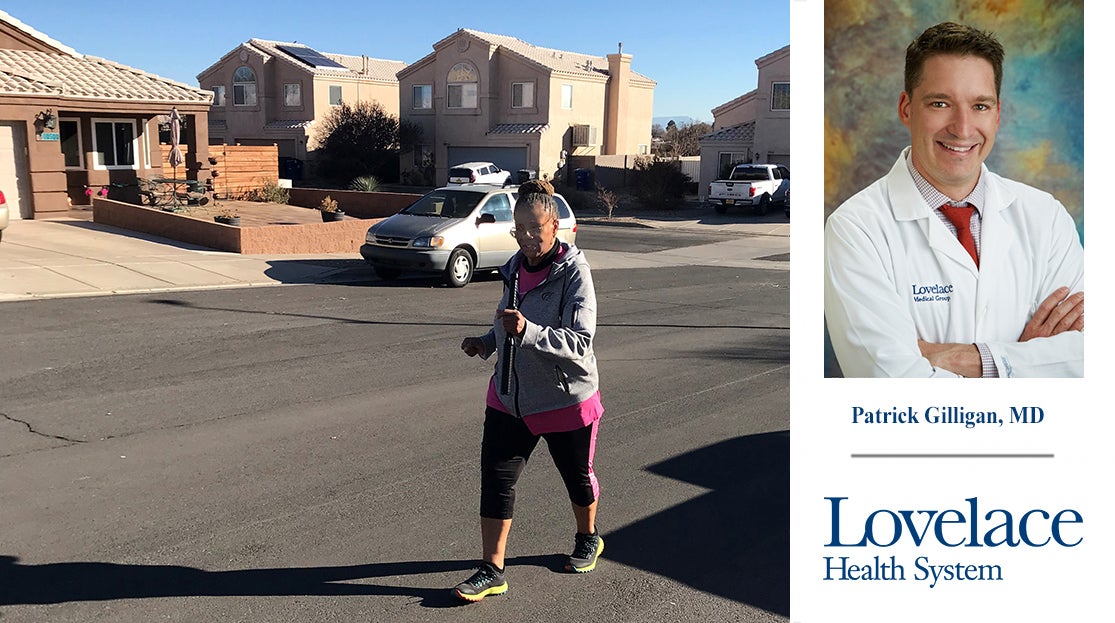If there’s someone who knows how to recover from hip replacement surgery and keep up with her fitness routine, it’s Michele Lewis.
The 60-year grandmother of three has spent the past 20 years as the Director of marketing and admissions at a skilled nursing facility in Albuquerque that offers short-term rehabilitation and other services.
An avid walker before her surgery, Michele regularly walked two miles throughout her neighborhood before work. She walked even longer distances on the weekend.
But when she started feeling pain in her hip that traveled down her leg, she knew it was time to see her doctor.
Diagnosis: osteoarthritis
“Around the time that COVID started, I started having intermittent pain in my hip and down my leg,” she explained. “One day I turned quickly and felt a shooting pain. I was afraid I had a fracture somewhere, so I went for an X-ray. The doctor didn’t see a fracture, so they told me it might be sciatic nerve pain and sent me home.”
Sciatic pain is often caused by a disc or bone spur that rests on the sciatic nerve, which starts at the pelvis, goes through the hip and runs down each leg.
“During this time I kept doing my morning walks, but the pain kept progressing and it was limiting my activities. That’s when I made an appointment with my primary care doctor for more x-rays. They determined it was ‘bone on bone’ osteoarthritis in my hip,” Michele said.
Osteoarthritis is a degenerative joint disease described as “wear and tear” arthritis, which happens when the cartilage between the bones in the hip starts breaking down after decades of rubbing together.
Michele’s doctor referred her to Dr. Patrick Gilligan, a Lovelace Medical Group orthopedic surgeon who performs surgeries at Lovelace Medical Center. Dr. Gilligan confirmed the diagnosis and recommended that she have her hip replaced.
Dr. Gilligan talked at length with Michelle about the procedure, such as how to prepare, what was going to happen and what to expect afterward. “Dr. Gilligan was very thorough on his part,” she said.
She would have to temporarily stop the medications she takes for high blood pressure and Type 2 diabetes, as well as some over-the-counter vitamins.
“After he explained everything, he said I could take some time to think about it. I told him right away that there was nothing to think about. I’ve been dealing with this pain for two years, so I am ready to move forward.”
Hip replacement surgery
To replace Michele’s hip, Dr. Gilligan used the Mako SmartRobotics™ system at Lovelace Medical Center. Using precise measurements of Michele’s hip and then placing temporary metal pins at key points above and below the hip, the system helped guide Dr. Gilligan to make very precise cuts. This kept as much of the healthy bone as possible and created a better fit so that everything locked together well.
He removed damaged sections of the hip joint: the femoral head (ball) at the top of the femur (thigh bone) and the Acetabulum (socket). He then replaced the damaged sections with new parts constructed of metal, ceramic and very hard plastic. The smoothness of these new parts will help reduce pain and improve Michele’s mobility.
Studies have shown that robotic surgery can provide a faster recovery rate than other surgical procedures, perhaps up to 50% less time to fully recover.
Rehabilitation for the future
Michele’s surgery was a success.
“The next day the nurses helped me get out of bed and right away I noticed that the pain I had been feeling for so long was no longer there,” she said. “While I waited for my family to pick me up, I even walked around the nurse’s station several times.”
A few days after the surgery, Michele was evaluated and scheduled for two rehabilitation sessions at Lovelace UNM Rehabilitation Hospital. “During one of the sessions, they asked if I had practiced how to get off the floor, in case I fell. And I said no; so we practiced that.”
Right mindset
In all, Michele went through four weeks of rehabilitation therapy. Once she could walk safely without a walker, she set a daily goal of walking two miles again in the morning. “Each day I would walk and go a little further. My app kept track of my distances by recording my steps. Once I could walk that distance, I knew I was on the road to recovery.”
Her recovery went so well that she was able to return to work four weeks ahead of schedule.
“It is a mindset thing, I believe,” Michele said. “I know that I have to work and not lay around, so I just made up my mind to work hard.” Michele continues to walk two miles every weekday morning before work. On the weekends, she will walk further, often up to five miles.
Recently she walked the long course (2.5 miles) at the annual “Walk to End Alzheimer’s” in Albuquerque’s Mariposa Basin Park.
Michele praises Dr. Gilligan and his staff for all they did for her. “Dr. Gilligan’s bedside manner is so comforting. He was very open and welcoming to my questions. The pre-surgery, the surgery and the post-surgery periods all went very well. The therapists were so good and gave me the exercises to recover from my surgery.”
She recommends Dr. Gilligan and his staff to anyone considering joint replacement surgery. “If you are hesitant, get all the information you can. In my case, it was the best decision I ever could have made.”
If you are experiencing pain in your knees, hips or other areas, call Lovelace Medical Group Orthopedics at (505) 727-2727. You can also read more and schedule an appointment on our Orthopedic Services web page.

